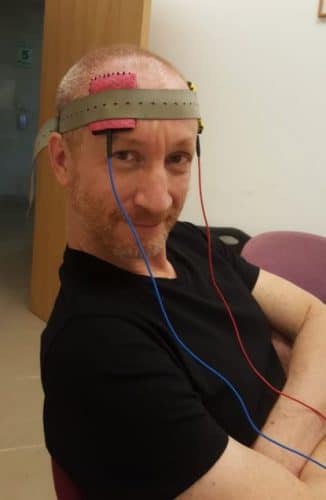A new study by Bar-Ilan University proves that one electrical stimulation is enough to improve abilities

A learning disorder is one of the most diagnosed developmental disorders in childhood. A specific learning disorder, or by its better known name - learning disability - can manifest itself in one (or more) of the following three areas: difficulty in reading, difficulty in writing or difficulty in mathematics (American Psychiatric Association, 2013). Studies report a prevalence of 4-9% in reading disabilities and 3-7% in math disabilities. According to a study among children in the third and fourth grades in Germany, it was found that boys show more difficulties in spelling than girls while girls show more difficulties in mathematics than boys. Furthermore, behavioral genetic studies provide evidence that reading and math disorders share a common genetic cause. Difficulty in reading leads to difficulties in reading comprehension. Reading comprehension is essential for the ability to acquire an education and a profession and to integrate in a beneficial way in society. Today, it is believed that the source of the disorder is brain and it does not depend on deprivations related to the environment or teaching.
While the treatments offered today for learning disabilities are focused on remedial teaching, we first investigated in Prof. Nira Meshal's language and brain laboratory at the Bar Ilan School of Education in Yossi Ehrenreich's doctoral thesis the possibility of improving reading comprehension by stimulating brain activity. More and more studies show that electrical brain stimulation in specific brain areas can improve verbal and cognitive function. Using a device for electrical stimulation of the brain (transcranial direct current stimulation-tDCS) we built an intervention program in which participants received weak electrical stimulation through two electrodes attached to their heads. The electric current is given at a low intensity and is not felt, and it is aimed at the frontal area of the brain (prefrontal cortex). See a photo of a student from the lab with the electrodes placed.
The purpose of the study was to examine the effect of one-time brain stimulation (experiment 1) and a series of sessions (experiment 2) on reading comprehension among adults with or without a learning disability. In the first experiment, 41 adults with a specific learning disability and 40 normal readers aged 18-29 participated. The participants were asked to answer a reading comprehension test in two sessions: in the first session we tested their reading comprehension when the participants received real (active) electrical stimulation and the second time a placebo stimulation (simulated stimulation without electricity) for 20 minutes. The participants did not know when they were receiving a real stimulus and when they were receiving a placebo stimulus. The results were encouraging: graduates with a learning disability improved their reading comprehension significantly when they received real prompting while those who received placebo prompting did not. Learning disabilities who received real guidance improved their reading comprehension from an initial comprehension level of 66% (before the guidance) to 79% after the guidance, that is, an improvement of 20%. As mentioned, there was no improvement in the learning disabled who received simulated stimulation. Similarly, an improvement was also obtained in normal reading adults, although the improvement is smaller: from an initial comprehension level of 84% to a reading comprehension level of 90% (after the electrical stimulation). Also, the improvement in the reading comprehension of the learning disability group was greater compared to the improvement observed in normal reading graduates.
30 participants with a learning disability (ages 18-19) participated in the second experiment. The participants attended a series of five meetings (day after day) and completed a reading comprehension test before and after the reading. Half of the participants received real electrical stimulation and half received a placebo stimulation. Similar to the first experiment, the results also showed this time that electric stimulation given to adults with a learning disability improves reading comprehension. The reading comprehension of those who received real prompting improved significantly (from a level of 71% to 90%). That is, both one-time prompting and a series of sessions produced similar results in the performance of the participants with a learning disability in the reading comprehension test.
The study showed for the first time that both one-time electrical stimulation and continuous electrical stimulation in the frontal brain region improves the reading comprehension of adults with learning disabilities and normal readers. The frontal area (in the frontal lobe) of the brain is involved in a variety of higher cognitive functions such as executive functions, working memory, decision making. This area provides an integrative neurological infrastructure for higher brain functions as required during reading comprehension. The study opens up the possibility of offering a treatment protocol for adults with a specific learning disorder with a reading comprehension disability. It should be noted that the use of the device is possible for adults only. Further research is needed to examine the length of time this intervention remains effective. More studies are needed to test the effectiveness of the tool in improving additional dysfunctions.
More of the topic in Hayadan:

2 תגובות
Between 66% and 79% there is an improvement of 13% (which is admittedly 20% of 66% but still confusing)
Minimal electrical stimulation or electroconvulsive therapy is used to treat movement and neuropsychiatric disorders and severe clinical depression. However she is seen as threatening. Scary, verified everything that has been leaked to the public for the last hundred plus years. Electric shocks, tying up and a map to the torture bed, the way is short in the imagination.
If the treatment stimulates the frontal lobe, then it can replace Ritalin for attention disorders that result from the lack of stimulation of the frontal lobe. It is interesting to read what the change in understanding is attributed to, concentration, managerial functions or an improved managerial attention profile? It will definitely be interesting and probably not relevant under a certain age.